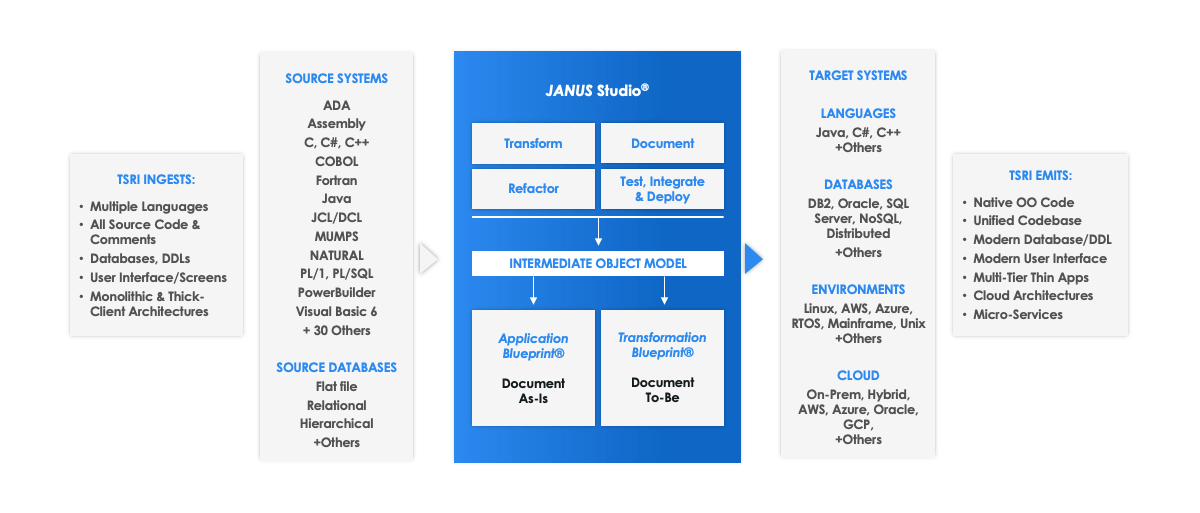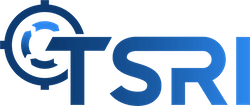Technology & Process Perfected Over 25 Years
The technology at the core of our solution, called JANUS Studio®, is built upon hard-work, experience, and ingenuity. We never stop improving. JANUS Studio® is the most advanced framework for automated software assessment and documentation, transformation, and refactoring.
We invite you to share in our vision of creating a world where organizations are not limited by technology.

True Semantic Transformation
Our fully automated toolset ingests each software application and truly transforms it into a modern, native, object-oriented target language such as C++, C#, Java, or J2EE, running on Linux, Unix, Windows, and other real-time target architectures.
TSRI Modernization Methods
TSRI delivers the highest quality modernized code at 100% automation levels.

Our component-oriented, model-based, architecture-first process supports UML and MDA.
IMPROVED CODE
THROUGH REFACTORING
CLEAR UNDERSTANDING
& INSIGHTS
GREATER FLEXIBILITY
& MAINTAINABILITY
We transform monolithic applications, their user interfaces and databases into multi-tiered, modular, and cloud-enabled applications into the desired architecture. Our solution features a powerful refactoring capability which helps iterate over code to increase maintainability, quality, and security. The flexible process allows for feedback and changes with each iteration, sprint, and spiral — applied to all code at the same time. The iterative nature of the process allows for a minimal code freeze and minimal business disruption.
TSRI ispreciseprovencollaborativedependableWe're here to help you!
SOURCE LANGUAGES
Assembly (Vax, HLASM, BAL)
Basic
C, C#, C++
CICS
CMS-2
COBOL
CA-IDEAL
COOLGEN & Other Generators
Dec Basic
EasyTrieve
Fortran
Java
JCL, DCL, Other Control Lang.
Jovial
MagnaX
MUMPS
NATURAL
PL/1
PL/SQL
PowerBuilder
Progress 4GL
RPG
Rust
SQL
VAX Basic (VB)
Visual Basic 6 (VB6)
LEGACY DATABASES
Sequential
Hierarchical
Relational
ISAM, VSAM, QSAM
DB2
CA-Datacom
Sybase
Adabas
+ Other Databases
Stored Procedures
Triggers
Views
LEGACY UI & SCREENS
MFS Screens
CA-IDEAL Panels
Data Windows
Conversational
Pseudo-Conversational
CICS
+ Other UI Elements
TARGET LANGUAGES
C#
C++
Java
Java J2EE
Java J2SE
Angular
TypeScript
HTML5
EGL
VB.NET
PL/SQL
Python
Rust
+ Other Languages
TARGET DATABASES
Oracle SQL Server
PostgreSQL
MariaDB
MongoDB
NoSQL
Aurora
Distributed Databases
+ Other Databases
TARGET PLATFORMS & ARCHITECTURES
Thin-Client Architectures
DAO layer
UI/Presentation layer
Application layer
Modern Frameworks
Bootstrap
SpringBoot
.NET & .NET Core
AngularJS
ReactJS
Google Guice & Closure
Web-Enablement
Cloud-Enablement
Fully Automated Introduction of:
RESTful interfaces
Micro-Services
Cloud Architectures (AWS, Azure, BlueMix, OpenStack, Google Cloud Platform, Cloud Foundry)
Languages listed above in bold include our limited Transformation Warranty,
where TSRI warrants the code to be free of any transformation-related errors or defects.
That is how accurate our modernization solution is.
The TSRI
Difference
Trusted provider for commercial, government, and military migrations
Frequently Asked Questions
There is no manual intervention required to transform code via our JANUS Studio® toolset; it is really 99.9X% automated. Even the little bit of a percent we hand patch we can roll into our automation for the next project.
This high degree of automation is due to our modeling process. As the first step during our modernization, TSRI needs to create a full and complete model of the application. This is where all the work that TSRI does, for example refactoring and redesigning, happens.
There are a few main reasons why legacy code modernizations fail.
First, manual rewrites can take a great deal of time, particularly for large applications. During this time, changes to the project goals may cause further delays or even cause the project to restart from the beginning. The cost for manual rewriting of code is already very high, and so starting over becomes particularly costly.
Also, long code freezes of months and years are common with manual or semi-automated conversions, which result in major issues for your user base, and eventually project failures.
Transliterative tools that focus on line-by-line translations of the source code into the modern code are also widely used. Just as using a dictionary to translate from another language to English one word or sentence at a time would result in many areas of confusion, so these tools produce results that don’t accurately reproduce the functionality of the original application. Even when completed, this results in complicated and unmaintainable applications.
Finally, the costs associated with large numbers of people on partially automated and manual modernization projects can be very high. These costs grow as features are added or changed several months or years into the project, until millions and often hundreds of millions have been invested.
The fully 100% automated functionality of TSRI’s JANUS Studio® solves all of these problems, and it's the reason all of our past projects were successfully completed, and all of our past projects are referenceable. This perfect track record of success has been honored with recognition ranging from the Stevens Award for our founder Philip Newcomb, as well as the Top 20 Most Promising Defense Technology award from CIO Review

